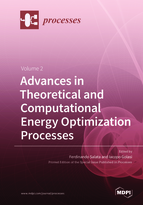Advances in Theoretical and Computational Energy Optimization Processes
A special issue of Processes (ISSN 2227-9717). This special issue belongs to the section "Energy Systems".
Deadline for manuscript submissions: closed (31 July 2019) | Viewed by 169080
Special Issue Editors
Interests: human thermal comfort; urban microclimate; heat transmission; buildings physics; thermodynamics; computational optimization; energy efficiency; lighting systems; environmental acoustics
Special Issues, Collections and Topics in MDPI journals
Interests: CFD simulation; numerical simulation; computational fluid dynamics; fluid mechanics; material characterization; engineering thermodynamics; numerical modeling; building; building materials; renewable energy technologies
Special Issue Information
Dear Colleagues,
Industry, construction and transport are the three sectors that traditionally lead to the highest energy requirements. This is why over the past few years all the involved stakeholders have widely expressed the necessity of introducing a new approach to the analysis and management of those energy processes characterizing the aforementioned sectors. The objective is to guide production and energy processes to an approach aimed at energy savings and a decrease in the environmental impact. Indeed, all the ecosystems are stressed by obsolete production schemes deriving from an unsustainable paradigm of constant growth and related to the hypothesis of an environment able to absorb and accept all the anthropogenic changes.
Leading the production processes of industry, construction and transport to a revision of their energy requirements is necessary and research activity is called to carry out its natural innovative function.
The industrial sector is in full transition and transformation towards its version 4.0 and is therefore called to review its management and supply costs of energy and raw materials to limit the environmental impact. Research activity must support best practices in energy management and encourage the reduction of greenhouse gas emissions. The construction sector should apply retrofit solutions able to increase energy efficiency, taking into account the environment and climate change at the same time. The transport sector is moving towards a new mobility with respect to the past, thanks to the transition from fossil fuels to electrification and the use of artificial intelligence, thus increasing the level of automation. In this context of great attention towards a sustainable and respectful future for the planet, the study and the diffusion of the results provided by the scientific community concerning the most recent progress in energy optimization is expected to play a key role.
With the aim of proposing the next generation of energy processes and leading to positive implications for the environment, climate and sustainability, this Special Issue "Advances in Theoretical and Computational Energy Optimization Processes" aims to collect sophisticated contributions on all these aspects, highlighting the current state of the art with respect to the results of the main research groups. Studies on energy processes, production methods and innovative mechanisms related to research based on computational optimization methods are all invited to be a part of this scientific collection. This Special Issue also wants to encourage a debate on the future scenarios in each of those sectors currently characterized by significant energy requirements.
Thanks and we hope you will consider participating in this Special Issue.
Sincerely,
Prof. Dr. Ferdinando SalataProf. Dr. Iacopo Golasi
Guest Editors
Manuscript Submission Information
Manuscripts should be submitted online at www.mdpi.com by registering and logging in to this website. Once you are registered, click here to go to the submission form. Manuscripts can be submitted until the deadline. All submissions that pass pre-check are peer-reviewed. Accepted papers will be published continuously in the journal (as soon as accepted) and will be listed together on the special issue website. Research articles, review articles as well as short communications are invited. For planned papers, a title and short abstract (about 100 words) can be sent to the Editorial Office for announcement on this website.
Submitted manuscripts should not have been published previously, nor be under consideration for publication elsewhere (except conference proceedings papers). All manuscripts are thoroughly refereed through a single-blind peer-review process. A guide for authors and other relevant information for submission of manuscripts is available on the Instructions for Authors page. Processes is an international peer-reviewed open access monthly journal published by MDPI.
Please visit the Instructions for Authors page before submitting a manuscript. The Article Processing Charge (APC) for publication in this open access journal is 2400 CHF (Swiss Francs). Submitted papers should be well formatted and use good English. Authors may use MDPI's English editing service prior to publication or during author revisions.
Keywords
- Energy efficiency
- Modelling and simulations
- Complex systems analysis
- Computational tools
- Artificial intelligence
- Optimized design
- Process systems engineering
- Industrial processes
- Buildings energy systems
- Transport infrastructures







